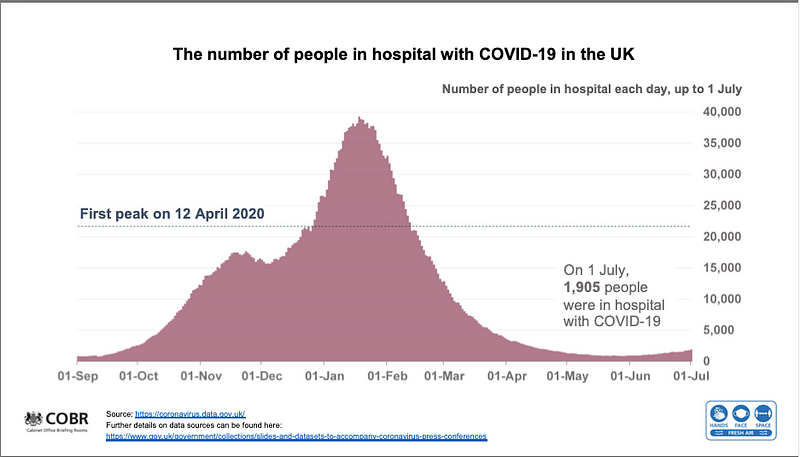Navigating the U.K.'s Controversial Path to Coexisting with COVID-19
Written on
Chapter 1: The U.K.'s Unconventional Approach
The United Kingdom has taken a bold stance, choosing to diverge from global trends for the third time since the onset of the pandemic.
A stark reminder of the past, the U.K.’s initial strategy during the pandemic led to devastating outcomes. The government’s early inclination toward achieving herd immunity resulted in a delayed lockdown, a decision that ultimately cost countless lives.
The second phase of the U.K.'s response was marked by a more proactive approach, as it became the first Western nation to launch a COVID-19 vaccination campaign. This was followed by a contentious decision to extend the interval between vaccine doses, which, despite initial criticism, yielded some positive outcomes.
Now, the U.K. finds itself at another crossroads. As of July 19, England will commence ‘phase 4’ of its COVID-19 response, significantly easing restrictions. Prime Minister Boris Johnson has declared an end to mandatory COVID-19 measures, urging citizens to take “personal responsibility.”
Under this new guidance, while the wearing of face masks will be encouraged, it will no longer be required. Social distancing measures will also be lifted, and the national ‘track and trace’ app will be discontinued. This shift occurs during a surge in infections, effectively signaling a return to normalcy amid one of the worst waves of the virus yet.

The U.K. is currently witnessing a dramatic spike in confirmed COVID-19 cases. Over the past week, 206,046 individuals tested positive, reflecting a 30.7% increase from the preceding week. The rapidly spreading ‘Delta Plus’ variant has emerged as the predominant strain, with daily cases surpassing 30,000. British Health Secretary has warned that following the so-called ‘freedom day,’ the country could see daily cases soar to 100,000.
Many health experts are expressing alarm regarding the decision to lift all restrictions at this juncture, especially given the current infection rates. A member of the government’s scientific advisory committee has criticized the removal of the mask mandate in enclosed spaces, while others argue that the vaccination rate in the U.K. remains insufficient for such significant changes, with only 50% of the population fully vaccinated. Umair Haque, a respected writer, commented that “Britain has officially lost its mind.”
To grasp the rationale behind the U.K.'s decision, it is essential to consider three pivotal graphs:
Graph #1:

This graph illustrates the number of confirmed COVID-19 cases, highlighting peaks in November 2020, January 2021, and July 2021.
Graph #2:

This chart tracks the number of patients hospitalized due to severe COVID-19 symptoms, with the same three critical dates in focus.
Graph #3:

The final graph presents data on COVID-19-related deaths, again emphasizing the same three key dates.
Despite the current rise in both hospitalizations and deaths, the proportion of severe outcomes compared to total infections is markedly different from earlier peaks. Although hospital admissions increased by 55.9% in the past week, this figure remains lower in relation to the number of infections compared to previous waves.
Vaccination efforts have significantly altered the death rate. A Cambridge University study reported that the ratio has shifted from 1 death per 90 infections in earlier peaks to 1 death per 1,000 infections in the current wave.
These statistics prompt a challenging inquiry: if these were the figures observed back in December 2019, would the global reaction to COVID-19 have been the same? Personally, I am doubtful.
Experts predict that COVID-19 will eventually become endemic, evolving into a virus that, while not eradicated, poses a reduced risk to the population due to increased immunity levels. In time, COVID-19 may function similarly to seasonal flu.
While influenza is often underestimated, it infects millions in the U.S. annually and results in tens of thousands of deaths. The flu is a complex virus that mutates regularly, rendering vaccines only partially effective (40%-60%). Yet, we coexist with it.
Critics argue that the U.K. is moving too hastily. This begs the question: when would it be appropriate to act? Should we delay for another month or year? What vaccination percentage is deemed adequate—60%, 70%, or 90%? Even in Israel, which boasts the highest vaccination rate with the effective Pfizer vaccine, rising infection rates due to the Delta variant persist.
A key concern among critics is the potential emergence of a new variant that could evade existing vaccines. Variants have been developing globally as long as COVID-19 continues to spread. Experts emphasize that no one is truly safe until everyone is safe. While current vaccines have demonstrated effectiveness against various strains, it is worth contemplating whether we should restrict our lives based on hypothetical scenarios.
I do not intend to advocate for the U.K.’s approach of treating COVID-19 as a minor issue. Living in London, I received my first vaccine dose and plan to remain cautious even after my second. I will continue to practice social distancing and wear a mask indoors long after the freedom day arrives.
However, I believe the U.K.'s decision is grounded in logic and scientific reasoning. We could argue for additional time, more data, or a larger vaccinated population. Perhaps. The impact of an extra month or year is uncertain, and I have yet to encounter anyone who can provide a definitive answer.
The advent of vaccines has fundamentally changed the landscape of the pandemic. It’s essential that we engage in meaningful discussions about what it truly means to coexist with the virus moving forward.
Chapter 2: The Global Perspective on COVID-19 Management
This video, titled "COVID-19, an Update and Critical Evaluation of the United Kingdom's Response," delves into the complexities of the U.K.'s handling of the pandemic and its implications for global health strategies.